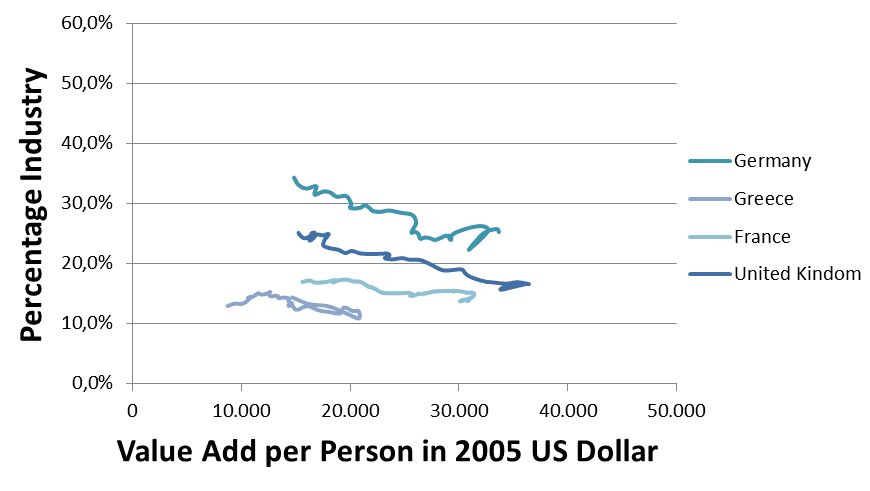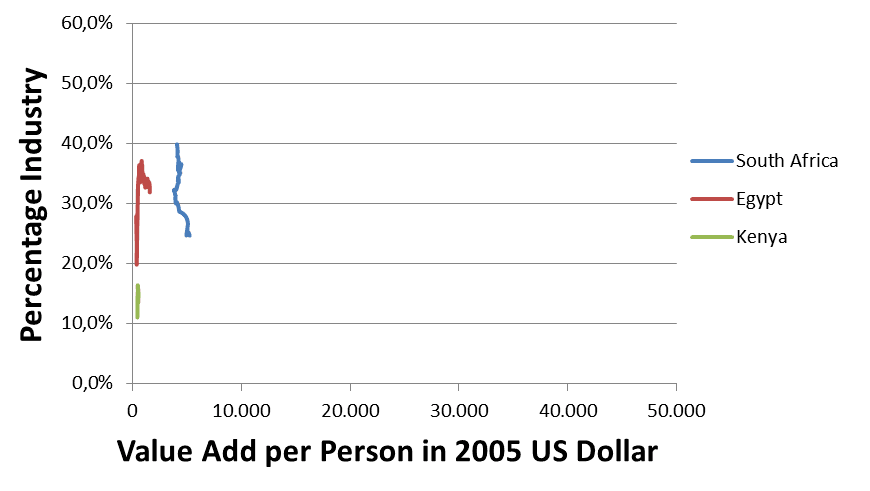 Manufacturing is an important part of most economies. However, during the development of an economy, manufacturing plays different roles at different times. In fact, manufacturing is a key stepping stone on the road to economic prosperity. During the development from an agricultural society to a service society, nations must go at one point through a industrial society.
Manufacturing is an important part of most economies. However, during the development of an economy, manufacturing plays different roles at different times. In fact, manufacturing is a key stepping stone on the road to economic prosperity. During the development from an agricultural society to a service society, nations must go at one point through a industrial society.
Big Data on Economic Relations
Historically, every nation starts out as an agricultural society. Up to before the industrial revolution, the economy of all nations was based on agriculture. Great Britain was the first nation to industrialize, followed shortly by Europe and North America. Nowadays, however, advanced economies are based mostly on service.
The graph below shows on the Y-axis the ratio of the output of the secondary sector (industry, mining, utilities) to the total value add, i.e. what part of the economy is based on the secondary sector. The X-axis shows the total value add per person, inflation adjusted into 2005 US Dollar. Each dot represents one of 131 countries for each year between 1970 and 2012, for a total of 5302 data points (For Details see Data Source below). The thick black line is the moving 255 value average.
At first glance, it seems to be a mess of data. However, if you look more closely, you can see a trend. Poor nations with a value add of less than $500 per person have very little industry, often as little as 5% of the total economy. However, industry increases steeply as the wealth of the nation improves. An average country with a value add of only $1000 per person has almost 30% of its economy in manufacturing. From then onward manufacturing holds steady until its peak of 30% for countries with a value add of around $7000 per person. After that the share of industry shrinks as countries become wealthier, leveling out at around 22% of the total value add.
There are very few nations with a value add per person of around $7000 that have less than 20% industry. It seems that on the way from agriculture to service, manufacturing is a necessary prerequisite to wealth. While the importance of manufacturing declines for wealthy first world service based nations, the path to the first world is through industry.
Below is the same graph, showing also the trend lines for the primary and tertiary sector. Clearly agriculture takes a nose dive while service increases. The steepest increase in relation to the starting point, however, is in industry.
Different Countries in Detail
Below are charts for selected countries in different continents. Please note that all charts have the same scale, and the data points show the development between 1970 and 2012.
Selected American Countries

Both the USA and Canada are wealthy first world countries with a value add of $45.000 and $35.000 respectively. The share of industry of the total economy is further declining. Mexico and Brazil on the other hand are developing second world countries. Both have a higher level of industrialization, although Brazil is in a decline.
Selected Asian Countries

Japan is a highly developed nation in its post-industrial phase. Industry is steady around 22% of total value add, although the burst real estate bubble in 1990 has stopped its advance. South Korea is a strong Asian tiger that is still jumping into becoming a first world country. The trend looks good, and if there is no war in Asia, South Korea may continue to increase its wealth.
China is still on its way, having over 40% of its economy in industry, while the average value add of a Chinese citizen is still barely on the level of Korea forty years ago. India is a mess. Lack of a political strategy has it standing still for the last forty years.
Selected European Countries

Europe is a continent with mostly first world nations. Germany, France, and the United Kingdom are all well in a post-industrial society, although Germany still has a strong manufacturing base. Greece made it over the hill into a post-industrial society, but since then has turned back due to the recession.
Selected African Countries
Africa is not anywhere close to North America, Europe, or Asia. South Africa is not getting any wealthier, and its share of industry as part of the economy is declining. Egypt is poor but industrialized, although the recent turmoils reduced the industry basis somewhat. Kenia is still a mostly agricultural country, where industrialization increases only very slowly.
Summary
In sum, all countries have to industrialize before they can become a wealthy service based society. As we have seen above, some countries are well industrialized, while others have made significant progress and are well on its way to prosperity. Other countries, however, seem to be stuck in a agricultural or poor early industrial society with little progress in the last 40 years. I hope this post and its big picture view was interesting to you. Now go out and improve your industry!
Appendix – Details on Source Data and Analysis
Raw Data courtesy of United Nations Statistic Division. The ratio of the Mining, Manufacturing, Utilities (ISIC C-E) to the Total Value Added (not the GDP) represents the Y-axis. The X-axis is the Total Value Added divided by the population of the country for that year. Data for 138 countries between 1970 and 2012 was considered. These countries were:
Afghanistan, Albania, Argentina, Armenia, Australia, Austria, Bangladesh, Belarus, Belgium, Belize, Benin, Bhutan, Bolivia, Bosnia and Herzegovina, Brazil, Bulgaria, Burundi, Cambodia, Cameroon, Canada, Central African Republic, Chile, China, Colombia, Congo, Democratic Republic of the, Costa Rica, Côte d'Ivoire, Croatia, Cuba, Cyprus, Czech Republic, Czechoslovakia (Former), D.P.R. of Korea, D.R. of the Congo, Denmark, Djibouti, Dominica, Dominican Republic, Ecuador, Egypt, El Salvador, Estonia, Ethiopia, Ethiopia (Former), Finland, France, Gambia, Georgia, Germany, Ghana, Greece, Guatemala, Guinea, Guinea-Bissau, Haiti, Honduras, Hungary, Iceland, India, Indonesia, Ireland, Israel, Italy, Japan, Jordan, Kazakhstan, Kenya, Kosovo, Lao People's DR, Latvia, Lesotho, Liechtenstein, Lithuania, Madagascar, Malawi, Malaysia, Mali, Malta, Mauritius, Mexico, Mongolia, Montenegro, Morocco, Mozambique, Namibia, Nepal, Netherlands, New Zealand, Nicaragua, Niger, Norway, Pakistan, Panama, Papua New Guinea, Paraguay, Peru, Philippines, Poland, Portugal, Republic of Korea, Republic of Moldova, Romania, Russian Federation, Senegal, Serbia, Sierra Leone, Singapore, Slovakia, Slovenia, South Africa, Spain, Sri Lanka, Suriname, Swaziland, Sweden, Switzerland, Syrian Arab Republic, Tajikistan, TFYR of Macedonia, Thailand, Trinidad and Tobago, Tunisia, Turkey, Turkmenistan, U.R. of Tanzania: Mainland, Ukraine, United Kingdom, United States, Uruguay, USSR (Former), Uzbekistan, Venezuela, Viet Nam, World, Yemen Arab Republic (Former), Yemen Democratic (Former), Yugoslavia (Former), Zimbabwe
Additional 84 countries have been excluded from the analysis, based on
- Mining Revenues >50% Value Add, therefore excluding for example oil exporters like Kuwait and Saudi Arabia
- Suspicion of flawed data, especially when the numbers don’t add up or the CIA world fact book gave very different values. This applies especially to some African nations like the Sudan or the Kongo
- Very small or fragmented nations like San Marion or the Seychelles due to a handicapped industrial development
The list of excluded states is:
Algeria, Andorra, Angola, Anguilla, Antigua and Barbuda, Aruba, Azerbaijan, Bahamas, Bahrain, Barbados, Bermuda, Botswana, British Virgin Islands, Brunei Darussalam, Burkina Faso, Cabo Verde, Cayman Islands, Chad, China: Hong Kong SAR, China: Macao SAR, Comoros, Congo, Cook Islands, Equatorial Guinea, Eritrea, Fiji, French Polynesia, Gabon, Greenland, Grenada, Guyana, Iran (Islamic Republic of), Iraq, Jamaica, Kiribati, Kuwait, Kyrgyzstan, Lebanon, Liberia, Libya, Luxembourg, Maldives, Marshall Islands, Mauritania, Micronesia, Micronesia (FS of), Monaco, Montserrat, Myanmar, Nauru, Netherlands Antilles, New Caledonia, Nigeria, Oman, Palau, Polynesia, Puerto Rico, Qatar, Rwanda, Saint Kitts and Nevis, Saint Lucia, Samoa, San Marino, Sao Tome and Principe, Saudi Arabia, Seychelles, Solomon Islands, Somalia, South Sudan, St. Vincent and the Grenadines, State of Palestine, Sudan, Sudan (Former), Timor-Leste, Togo, Tonga, Turks and Caicos Islands, Tuvalu, Uganda, United Arab Emirates, Vanuatu, Yemen, Zambia, Zanzibar
The moving average is based on 255 values. This is the average of the percentages, hence the average was not weighted according to the size of the nation.
 PS: If you would like to read more about history of manufacturing, then check out my book:
PS: If you would like to read more about history of manufacturing, then check out my book:
Roser, Christoph, 2016. “Faster, Better, Cheaper” in the History of Manufacturing: From the Stone Age to Lean Manufacturing and Beyond, 439 pages, 1st ed. Productivity Press.



